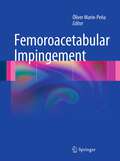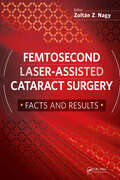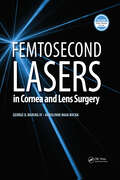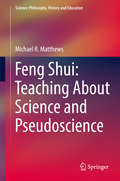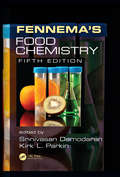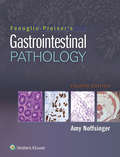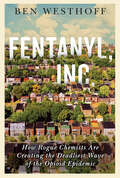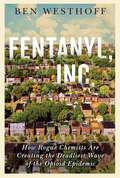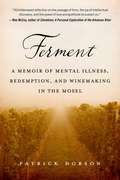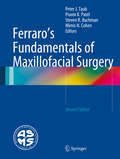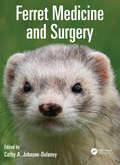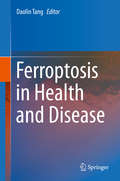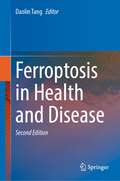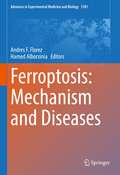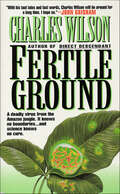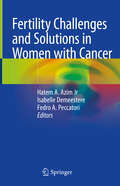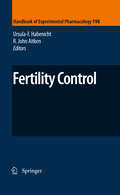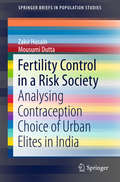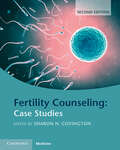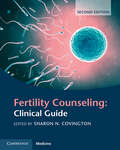- Table View
- List View
Femoroacetabular Impingement
by Óliver Marín-PeñaThis book is the first monograph to examine all aspects of femoroacetabular impingement (FAI), an important disease first described early in the twenty-first century. Comprising 27 chapters and including many color illustrations, the book contains a variety of points of view from more than 50 experts from 11 countries and represents an up-to-date compilation of professional knowledge on FAI. The full range of available surgical treatments is carefully described and evaluated, including arthroscopic treatment, the open and mini-open approaches, periacetabular osteotomy, hip resurfacing arthroplasty, and combined techniques. Differential diagnosis, imaging, postoperative management, and treatment outcome are also discussed in appropriate detail. It is hoped that this book will promote a comprehensive approach to what is a common pathology and thereby encourage further improvement in treatment.
Femtosecond Laser Assisted Lenticule Extraction: Principles, Techniques, Complication Management, and Future Concepts in KLEx
by Walter Sekundo Felix Mathias WagnerThis is the first comprehensive textbook on Keratorefractive Lenticule Extraction (KLEx). In fact, this new textbook is an expansion and update of the successful book, SMILE, that was published in 2015. The new edition has now been expanded to include all available KLEx procedures such as SMILE/SMILE Pro, SmartSight, CLEAR, and SILK. For the second time, the editors managed to gather a group of excellent international researchers and clinicians from all parts of the world as authors of the individual chapters. The publication follows the proven concept of the first edition, providing a clear, step-by-step approach encompassing the fundamentals, healing response, energy management, biomechanics, complications management, and surgical pattern for KLEx in general and each specific procedure in particular. For the first time, the reader will not only be able to understand KLEx in detail but also to appreciate differences in technologies available on the market.
Femtosecond Laser-Assisted Cataract Surgery: Facts and Results
by Zoltan NagyDr. Zoltan Z. Nagy performed the first femtosecond laser-assisted cataract surgery in a human eye in 2008. As one of the most authoritative sources on the topic, Femtosecond Laser-Assisted Cataract Surgery: Facts and Results presents the history of the development and use of femtosecond laser-assisted cataract surgery summarizes the results of five years of pioneering techniques by Dr. Nagy and his team, including personal reflections and thoughts, as well as a series of classic papers.Femtosecond Laser-Assisted Cataract Surgery consists of two main sections. The first section discusses and reviews the new results for the reader from the research. The second section comprises original articles on the topic of femtosecond laser cataract surgery that is essential to ophthalmologists.Additional features include:• A review of the current state-of-the-art usages of femtosecond laser-assisted cataract surgery• Examine existing technologies that compete with femtosecond laser-assisted cataract surgery and compare outcomes• Discuss key secrets to successful surgical techniques using femtosecond laser-assisted cataract surgery• How to address and manage common complications associated with femtosecond laser-assisted cataract surgeryFemtosecond Laser-Assisted Cataract Surgery presents these clinical results with cataract and corneal application, and highlights basic research with the strength of the anterior capsule and will assist ophthalmologists and residents alike gain a better understanding of the femtosecond laser cataract surgery process.
Femtosecond Lasers in Cornea and Lens Surgery
by George Waring Karolinne RochaFor ophthalmologists who are already using femtosecond lasers as well as those just starting out who are looking for the definitive reference manual, Femtosecond Lasers in Cornea and Lens Surgery is a comprehensive, cutting-edge guide to this technology that features a robust supplemental website with nearly 40 surgical videos. With the advent of small incision lenticule extraction, pockets and channels for corneal inlays and ring segments, femtosecond lasers for corneal surgery have advanced significantly over the past several decades, and ophthalmologists are looking for expert guidance on their acquisition, utilization, and optimization. With contributions from world-renowned surgeons who have seen the benefit of integrating femtosecond laser technology into their practices, this text reviews the practical aspects of femtosecond technology and also addresses the future of this quickly evolving space. Drs. George O. Waring, IV and Karolinne Maia Rocha lead their team of more than 50 expert contributors in providing a thorough, definitive text summarizing all aspects of femtosecond lasers for corneal and lens surgery in a balanced and commercially unbiased manner. All of the major platforms and systems are covered in chapters including: Integration of Femtosecond Laser–Assisted Cataract Surgery Into Your Practice Therapeutic Laser Assisted Cataract Surgery Complications of Femtosecond LASIK Small Incision Lenticule Extraction Femtosecond Laser Pockets for Corneal Inlays Use of Femtosecond Lasers in Keratoplasty For a comprehensive resource on the use of femtosecond lasers in cornea and lens surgery, as well as unbiased opinions from expert contributors on the various procedures and platforms, Femtosecond Lasers in Cornea and Lens Surgery is a must-have for ophthalmologists wishing to stay on top of this evolving field.
Feng Shui: Teaching About Science and Pseudoscience (Science: Philosophy, History and Education)
by Michael R. MatthewsThis book provides a richly documented account of the historical, cultural, philosophical and practical dimensions of feng shui. It argues that where feng shui is entrenched educational systems have a responsibility to examine its claims, and that this examination provides opportunities for students to better learn about the key features of the nature of science, the demarcation of science and non-science, the characteristics of pseudoscience, and the engagement of science with culture and worldviews. The arguments presented for feng shui being a pseudoscience can be marshalled when considering a whole range of comparable beliefs and the educational benefit of their appraisal.Feng shui is a deeply-entrenched, three-millennia-old system of Asian beliefs and practices about nature, architecture, health, and divination that has garnered a growing presence outside of Asia. It is part of a comprehensive and ancient worldview built around belief in chi (qi) the putative universal energy or life-force that animates all existence, the cosmos, the solar system, the earth, and human bodies. Harmonious living requires building in accord with local chi streams; good health requires replenishment and manipulation of internal chi flow; and a beneficent afterlife is enhanced when buried in conformity with chi directions. Traditional Chinese Medicine is based on the proper manipulation of internal chi by acupuncture, tai-chi and qigong exercise, and herbal dietary supplements. Matthews has produced another tour de force that will repay close study by students, scientists, and all those concerned to understand science, culture, and the science/culture nexus.Harvey Siegel, Philosophy, University of Miami, USA With great erudition and even greater fluidity of style, Matthews introduces us to this now-world-wide belief system.Michael Ruse, Philosophy, Florida State University, USA The book is one of the best research works published on Feng Shui. Wang Youjun, Philosophy, Shanghai Normal University, China The history is fascinating. The analysis makes an important contribution to science literature.James Alcock, Psychology, York University, Canada This book provides an in-depth study of Feng Shui in different periods, considering its philosophical, historical and educational dimensions; especially from a perspective of the ‘demarcation problem’ between science and pseudoscience. Yao Dazhi, Chinese Academy of Sciences, China
Fennema's Food Chemistry
by Srinivasan Damodaran Kirk L. ParkinThis latest edition of the most internationally respected reference in food chemistry for more than 30 years, Fennema’s Food Chemistry, 5th Edition once again meets and surpasses the standards of quality and comprehensive information set by its predecessors. All chapters reflect recent scientific advances and, where appropriate, have expanded and evolved their focus to provide readers with the current state-of-the-science of chemistry for the food industry. This edition introduces new editors and contributors who are recognized experts in their fields.The fifth edition presents a completely rewritten chapter on Water and Ice, written in an easy-to-understand manner suitable for professionals as well as undergraduates. In addition, ten former chapters have been completely revised and updated, two of which receive extensive attention in the new edition including Carbohydrates (Chapter 3), which has been expanded to include a section on Maillard reaction; and Dispersed Systems: Basic considerations (Chapter 7), which includes thermodynamic incompatibility/phase separation concepts.Retaining the straightforward organization and accessibility of the original, this edition begins with an examination of major food components such as water, carbohydrates, lipids, proteins, and enzymes. The second section looks at minor food components including vitamins and minerals, colorants, flavors, and additives. The final section considers food systems by reviewing basic considerations as well as specific information on the characteristics of milk, the postmortem physiology of edible muscle, and postharvest physiology of plant tissues.
Fenoglio-Preiser's Gastrointestinal Pathology
by Amy E. NoffsingerWith extensively revised content and an expanded contributor list of experts, Fenoglio-Preiser’s Gastrointestinal Pathology, Fourth Edition keeps you current in this fast-changing field. This highly regarded text remains your go-to reference on gastrointestinal pathology, with coverage of everything from anatomy, physiology, and histology to the full spectrum of congenital disorders, structural alterations, diseases, injuries, and other entities. This comprehensive reference is an ideal resource for pathologists, radiologists, gastroenterologists, and others interested in gastrointestinal diseases.
Fentanyl Nation: Toxic Politics and America's Failed War on Drugs
by Ryan HamptonA passionate call to abandon ineffective drug-war policies, reframe addiction as a public health issue, and end the Fentanyl crisis.The American overdose crisis has reached record-breaking heights; preventable overdoses are now responsible for more annual deaths than traffic accidents, suicide, or gun violence. Fentanyl—a potent, inexpensive, and easy-to-manufacture synthetic opioid—has thoroughly contaminated the drug supply, and while it frequently makes front page news across the country, it remains poorly understood by policymakers and the public. Why, despite all of our efforts to raise awareness and billions of dollars of investments, does this emergency keep getting worse?In Fentanyl Nation, recovery advocate Ryan Hampton separates the facts from the fiction surrounding Fentanyl, and shows how overdose deaths are ultimately policy failures. Instead of investing in education, harm reduction, effective treatment, and recovery, we have doubled down on more police, more incarceration, and harsher penalties for those caught in the grip of addiction. Yet history has shown time and time again that it is impossible to arrest our way out of a public health crisis; the government used the same strategy to fight the crack-cocaine epidemic of the 80s and 90s, and it only resulted in racially disparate policing and the destruction of marginalized communities.This urgent and informative manifesto reveals how prejudice, discrimination, and stigma have been codified into our drug laws, and calls for a compassionate and evidence-based approach that would address the core causes of addiction and save countless lives. We can end this crisis, but only if we get out of our own way.
Fentanyl, Inc.: How Rogue Chemists Are Creating the Deadliest Wave of the Opioid Epidemic
by Ben WesthoffA four-year investigation into the world of synthetic drugs?from black market factories to users & dealers to harm reduction activists—and what it revealed.A deeply human story, Fentanyl, Inc. is the first deep-dive investigation of a hazardous and illicit industry that has created a worldwide epidemic, ravaging communities and overwhelming and confounding government agencies that are challenged to combat it. “A whole new crop of chemicals is radically changing the recreational drug landscape,” writes Ben Westhoff. “These are known as Novel Psychoactive Substances (NPS) and they include replacements for known drugs like heroin, cocaine, ecstasy, and marijuana. They are synthetic, made in a laboratory, and are much more potent than traditional drugs” —and all-too-often tragically lethal.Drugs like fentanyl, K2, and Spice?and those with arcane acronyms like 25i-NBOMe? were all originally conceived in legitimate laboratories for proper scientific and medicinal purposes. Their formulas were then hijacked and manufactured by rogue chemists, largely in China, who change their molecular structures to stay ahead of the law, making the drugs’ effects impossible to predict. Westhoff has infiltrated this shadowy world. He tracks down the little-known scientists who invented these drugs and inadvertently killed thousands, as well as a mysterious drug baron who turned the law upside down in his home country of New Zealand. Westhoff visits the shady factories in China from which these drugs emanate, providing startling and original reporting on how China’s vast chemical industry operates, and how the Chinese government subsidizes it. Poignantly, he chronicles the lives of addicted users and dealers, families of victims, law enforcement officers, and underground drug awareness organizers in the United States and Europe. Together they represent the shocking and riveting full anatomy of a calamity we are just beginning to understand. From its depths, as Westhoff relates, are emerging new strategies that may provide essential long-term solutions to the drug crisis that has affected so many.“Timely and agonizing. . . . An impressive work of investigative journalism.” —USA Today“Westhoff explores the many-tentacled world of illicit opioids, from the streets of East St. Louis to Chinese pharmaceutical companies, from music festivals deep in the Michigan woods to sanctioned ‘shooting up rooms’ in Barcelona, in this frank, insightful, and occasionally searing exposé. . . . Westhoff’s well-reported and researched work will likely open eyes, slow knee-jerk responses, and start much needed conversations.” —Publishers Weekly“Our 25 Favorite Books of 2019” —St. Louis Post-Dispatch“Best Books of 2019” —Buzzfeed“Best Nonfiction of 2019” —Kirkus Reviews“50 Best Books of 2019” —Daily Telegraph“Best Nonfiction Books of 2019” —Tyler Cowen“Best Books of 2019” —Yahoo Finance
Fentanyl, Inc: How Rogue Chemists are Creating the Deadliest Wave of the Opioid Epidemic
by Ben WesthoffA deeply human story, Fentanyl, Inc. is the first deep-dive investigation of an illicit industry that has created a worldwide epidemic, ravaging communities and overwhelming and confounding government agencies that are challenged to combat it. "A whole new generation of chemicals is radically changing the recreational drug landscape," writes Ben Westhoff. "These are known as novel psychoactive substances (NPS) and they include replacements for known drugs like ecstasy, LSD, and marijuana, as well as heroin. They are synthetic, made in a laboratory... and they are much more potent than traditional drugs"--and, tragically, all-too-often lethal. Drugs like fentanyl, K2, and Spice--and those with arcane acronyms like 25I-NBOMe--were all originally conceived in legitimate laboratories for proper scientific and medicinal purposes. Their formulas were then hijacked and manufactured by rogue chemists, largely in China, who change their molecular structures to stay one step ahead of the law, often making the drugs' effects impossible to predict. Westhoff has infiltrated this shadowy world. He tracks down the little-known scientists who invented these drugs and inadvertently killed thousands, as well as a mysterious drug baron who turned the law upside down in his home country of New Zealand. Westhoff is the first journalist ever to infiltrate a Chinese fentanyl lab. Working undercover, he gains entry to a pair of synthetic drug operations from which fentanyls and other NPS emanate, providing startling and original reporting on how China's vast chemical industry operates, and how the Chinese government subsidizes it. He poignantly chronicles the lives of addicted users and dealers, families of victims, law enforcement officers, and underground drug awareness organizers in the U.S. and Europe. Together they represent the shocking and riveting full anatomy of a calamity we are just beginning to understand. From its depths, as Westhoff relates, are emerging new strategies that may provide essential long-term solutions to the drug crisis that has affected so many.
Ferdinand Sauerbruch - Meisterchirurg im politischen Sturm: Eine kompakte Biographie für Ärzte und Patienten (essentials)
by Wolfgang U. EckartWolfgangU. Eckart setzt sich vornehmlich mit dem politischen Sauerbruch - oder besser:der politischen Selbstinszenierung des gro#65533;en Chirurgen - im Wandel derSysteme, die seinen Lebensweg begleiteten, auseinander. Insbesondere die #65533;berweite Strecken von seinem Ghostwriter konstruierte, teilweise erfundene,Autobiographie' ,,Das war mein Leben" hat dem Publikum zusammen mit dem aufihrer Grundlage entstandenen Spielfilm einen idolhaften Artztypus vorgehalten,der m#65533;glicherweise f#65533;r mindestens eine ganze Generation junger Medizinervorbildhaft wirkte. Aber Sauerbruch entsprach diesem entworfenen Bild nicht. Erhat sich auf eine bisweilen schwer verst#65533;ndliche, bisweilen sogar unertr#65533;glicheWeise mit den jeweiligen politischen Machthabern arrangiert und gleichzeitigimmer wieder auch Ambivalenzen und Br#65533;che offenbart.
Ferment: A Memoir of Mental Illness, Redemption, and Winemaking in the Mosel
by Patrick DobsonA deeply moving account of one man&’s return to the German town where he first pursued a career in winemaking, and his attempt to reckon with the mental illness, alcoholism, and enduring relationships that defined the most formative chapter of his life.After an attempted suicide by hanging—with his son in the next room—author Patrick Dobson checks into a mental hospital, clueless, reeling from bone-crushing depression and tortuous, racing thoughts. A long overdue diagnosis of manic depression offers relief but brings his confused and eventful past into question.To make sense of his suicide attempt and deal with his past, he returns to Germany where, three decades earlier, he arrived as twenty-two-year-old—lost, drunk, and in the throes of untreated mental illness—in search of a new life and with dreams of becoming a winemaker. The sublime Mosel vineyards and the ancient city of Trier changed his life forever.Ferment charts his days in Trier&’s vineyards and cellars, and the enduring friendships that would define his life. A winemaker and his wife become like parents to him. In their son, he finds a brother, whose death years later sends Dobson into a suicidal tailspin. His friends, once apprentices like himself, become leaders in their fields: an art historian and church-restoration expert, an art- and architectural-glass craftsman, a painter and photographer, and a theologian/journalist. The relationships he builds with them become hallmarks of a life well-lived.In Ferment, Dobson reconnects with the people who stood by him through his dissolution and eventual recovery. In these relationships, he seeks who he was and how his time in Germany changed him. He peers into his memory to understand how manic depression and alcoholism affected who he was then and how his time in Germany made him who he&’s become.
Fermentation Microbiology and Biotechnology, Fourth Edition
by Jens Nielsen E. M. El-Mansi David Mousdale Ross P. CarlsonFermentation Microbiology and Biotechnology, 4th Edition explores and illustrates the broad array of metabolic pathways employed for the production of primary and secondary metabolites, as well as biopharmaceuticals. This updated and expanded edition addresses the whole spectrum of fermentation biotechnology, from fermentation kinetics and dynamics to protein and co-factor engineering. It also sheds light on the new strategies employed by industrialist for increasing tolerance and endurance of microorganisms to the accumulation of toxic wastes in microbial-cell factories. The new edition builds upon the fine pedigree of its earlier predecessors and extends the spectrum of the book to reflect the multidisciplinary and buoyant nature of this subject area. Key Features Covers the whole spectrum of the field from fermentation kinetics to control of fermentation and protein engineering. Includes case studies specifically designed to illustrate industrial applications and current state-of-the-art technologies. Presents the contributions of eminent international academics and industrial experts. Offers new chapters addressing: The prospects and the role of bio-fuels refineries, Control of metabolic efflux to product formation in microbial-cell factories and Improving tolerance of microorganisms to toxic byproduct accumulation in the fermentation vessel.
Ferraro's Fundamentals of Maxillofacial Surgery
by Peter J. Taub Pravin K. Patel Steven R. Buchman Mimis N. CohenFerraro's Fundamentals of Maxillofacial Surgery is the newly revised and updated second edition of the text originally edited by James W. Ferraro. Written for trainees and students as well as experts in oral and maxillofacial surgery, and experts in related subspecialties such as otolaryngology and plastic surgery, this highly illustrated text is an invaluable source of hands-on, practical knowledge for those taking the ASMS Basic Course, or for any specialist seeking a comprehensive review of maxillofacial surgery.
Ferret Medicine and Surgery
by Cathy Johnson-DelaneyThe text is currently the most up-to-date book on ferret medicine and as such, would be an important addition to the library of veterinary practices seeing these lively, curious and fun-loving pets. Aidan Raftery, Veterinary Record 17 March 2018 Ferrets are becoming increasingly popular as pets, rivalling rabbits as the third most favoured domestic pet after dogs and cats. Ferret Medicine and Surgery discusses the veterinary aspects of this incredible little creature. The book covers ferret medicine and common surgeries, providing a comprehensive reference for the veterinary practitioner. Each chapter of disorders is designed to be inclusive and includes cross references to other chapters throughout as well as some highlights of anatomy and physiology as a review. The format allows easy access to information providing answers to problems that arise in practice. Thoroughly illustrated with high-quality photographs and line drawings, the book is designed to provide quick, concise information of immediate use to the practitioner.
Ferroptosis in Health and Disease
by Daolin TangThis book sheds new light on ferroptosis, as an only recently recognised form of regulated cell death. Its respective chapters address the numerous implications that ferroptosis can have for virtually all aspects of metabolism. They also share insights on the morphological characterisation of ferroptosis and highlight the different pathways of induction. Accordingly, the book offers a unique perspective on a mechanism that is involved in a multitude of pathologies, including cancer cell death, neurotoxicity, neurodegenerative diseases, acute renal failure, drug-induced hepatotoxicity, tissue ischemia/reperfusion injury, and T cell immunity. Readers will learn in which cell types this form of regulated cell death is likely to occur, and how it can be pharmacologically influenced, making the book a fascinating and informative read not only for scientists working in cell biology, but also for clinicians in the field of cancer research.
Ferroptosis in Health and Disease
by Daolin TangThis updated and expanded volume gives new insights on ferroptosis – an iron-dependent form of non-apoptotic cell death. The collection of chapters discusses the two major pathways through which ferroptosis can occur: the extrinsic or transporter-dependent pathway and the intrinsic or enzyme-regulated pathway.Readers will gain an understanding of the multiple levels, on which this special cell death is regulated. Hence, the contributions will take a closer look at epigenetic, transcriptional, posttranscriptional and posttranslational layers. Among the described regulators and transcription factors are GPX4, ACSL4 and NFE2L2. This edited volume collects reviews related to current knowledge on the integrated molecular machinery of ferroptosis, thereby also describing how dysregulated ferroptosis is involved in human diseases.
Ferroptosis: Mechanism and Diseases (Advances in Experimental Medicine and Biology #1301)
by Hamed Alborzinia Andrés F. FlorezThis book focuses on the emerging role of ferroptosis in human diseases. It gives a detailed perspective on how to induce or suppress ferroptosis to treat challenging conditions such as infectious diseases, including COVID-19, tuberculosis, parasitic diseases and cancer. The book serves as a practical guide by providing a valuable collection of all currently known activators or inhibitors of ferroptosis. It will enable readers to choose molecules for experimental design for in vitro and in vivo studies of ferroptosis. Furthermore, this volume highlights the aspects of iron metabolism and its connection to ferritinophagy, a ferritin selective autophagy, with profound implications in neurodegenerative diseases such as Alzheimer, Parkinson, Huntington and ALS. Lastly, it describes necroptosis, another important form of cell death, along with its connections to human disorders and potential crosstalk with ferroptosis. While covering basic concepts, the book delves into mechanisms and modulation of ferroptosis for treating a wide variety of human diseases thus offering a valuable and informative resource for both, scientists and clinical researchers.
Fertile Ground
by Charles WilsonA team of scientists explore an uncharted region of the Amazon, seeking exotic plants that may yield cures for the diseases afflicting humanity. But their mission goes horribly wrong when the party is attacked by the area's mysterious natives, and when they learn too late that they've landed in the cauldron of a deadly, unknown virus.
Fertility Challenges and Solutions in Women with Cancer
by Hatem A. Azim Isabelle Demeestere Fedro A. PeccatoriThis book, written by global experts in the field, provides a thorough overview on fertility and pregnancy challenges and solutions in women who are being or have been treated for cancer. The book addresses several topics, including pregnancy outcomes after a cancer diagnosis, the impacts of systemic anticancer therapy on fertility, the essentials of fertility preservation approaches in cancer patients, and fertility counseling. This is in addition to controversial topics like the role of ovarian stimulation in breast cancer patients, fertility preservation in cancer patients with BRCA mutation and the evolving role of GnRH analogues. Within this context, key open questions are discussed with reference to the latest evidence. The aim is to provide clinicians with a reliable resource that documents the most up-to-date knowledge on the feasibility and safety of the different approaches to fertility preservation and on the management of female cancer patients who would like to preserve fertility and achieve a pregnancy following their treatment.
Fertility Control
by Robert John Aitken Ursula-F. HabenichtThis book represents a unique collection of papers from internationally renowned experts to give us a state-of-the art summary of current concepts in reproductive biology. The narrative has been developed to highlight how new gains in our understanding of reproductive mechanisms have generated unique opportunities for contraceptive development.
Fertility Control in a Risk Society
by Zakir Husain Mousumi DuttaThis book analyses the reasons for relying on behavioural contraception methods among urban 'elites' in India and examines their efficacy in controlling fertility. It also traces variations in contraception choice over the reproductive cycle of women. Although researchers and policy makers generally equate reliance on behavioural contraceptive methods with low levels of education and awareness and lack of desire to control fertility, this perception has been questioned in recent years. The authors' analysis of the first three rounds of the National Family Health Survey (NFHS) data in India reveals that behavioural contraceptive methods are popular in eastern India. Moreover, it is urban educated women who rely on behavioural methods, and are apparently able to regulate fertility quite effectively with such methods. NFHS data, however, has some limitations and this motivates the authors to explore birth control methods through primary surveys of currently married graduate women in Kolkata. The use of behavioural contraception methods is a little researched area globally and this is the first book focusing on the topic in India.
Fertility Counseling
by Sharon N. CovingtonUsing real-world cases, this clinical guide details the psychosocial challenges faced by patients navigating the world of medically assisted reproduction (MAR). It describes in depth the latest perspectives on counseling approaches to the evolving complexities of family creation, whether fertility issues are a presenting problem or occur during the course of therapy or the aftermath of a struggle with infertility. Applying an evidence-based, cross-border approach, international experts not only discuss advanced perspectives on topics such as third party reproduction, pregnancy loss and adoption, but also newer issues of fertility preservation, 'older' patient parenthood, LGBT and singles' family creation. A comprehensive resource, it explores pioneering insights into fertility counseling such as spirituality, developing disclosure language, a counselor's personal fertility issues, and more. This is an essential aid for medical and mental health professionals to develop and refine the skills needed to treat the increasingly diverse and complex needs of MAR patients.
Fertility Counseling: Case Studies
by Sharon CovingtonThis second edition of the essential guide for reproductive professionals is now available in a Clinical Guide and a Case Studies Guide, presenting the most current knowledge on counseling patients with diverse needs amidst rapidly advancing modern technology. The Case Studies guide relates the accessible, real-world experiences and perspectives as leading international practitioners share their stories applying clinical concepts to treatment practice. Chapters cover current, unaddressed and emerging areas in reproductive mental health including consequences of direct-to-consumer DNA testing, racial and cultural sensitivity and tele-mental health. Among the new topics are transgender ART, recurrent pregnancy loss, post-partum adjustment, and the pregnant therapist. For an in-depth presentation of clinical concepts, discover the Clinical Guide, which provides a foundational understanding of the medical and psychosocial experience of fertility treatment. An essential aid for medical and mental health professionals, this comprehensive guide allows clinicians to develop and refine the skills required to address the increasingly complex needs of fertility patients.
Fertility Counseling: Clinical Guide
by Sharon CovingtonThe second edition of the essential guide for reproductive professionals is now available in a Clinical Guide and a Case Studies Guide, presenting the most current knowledge on counseling diverse patients amidst rapidly advancing modern technology. Follow an in-depth presentation of clinical concepts in this Clinical Guide for a foundational understanding of the medical and psychosocial experience of fertility treatment. Explore the areas of reproductive psychology, therapeutic approaches, assessment and preparation in assisted reproduction, addressing the needs of diverse populations, and clinical practice issues. Featuring new topics such as transgender ART, recurrent pregnancy loss, post-partum adjustment, and the pregnant therapist. Then in Case Studies, discover the accessible, real-world experiences and perspectives as leading international practitioners share their stories applying clinical concepts to treatment practice. An essential aid for medical and mental health professionals, this comprehensive guide allows clinicians to develop and refine the skills required to address the increasingly complex psychosocial needs of fertility patients.
